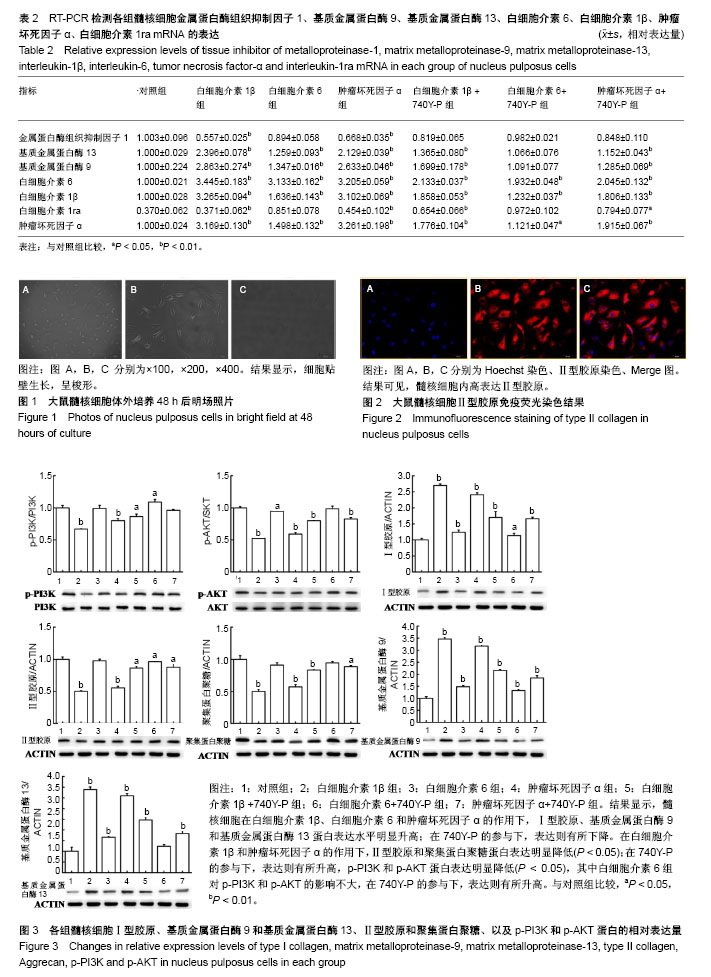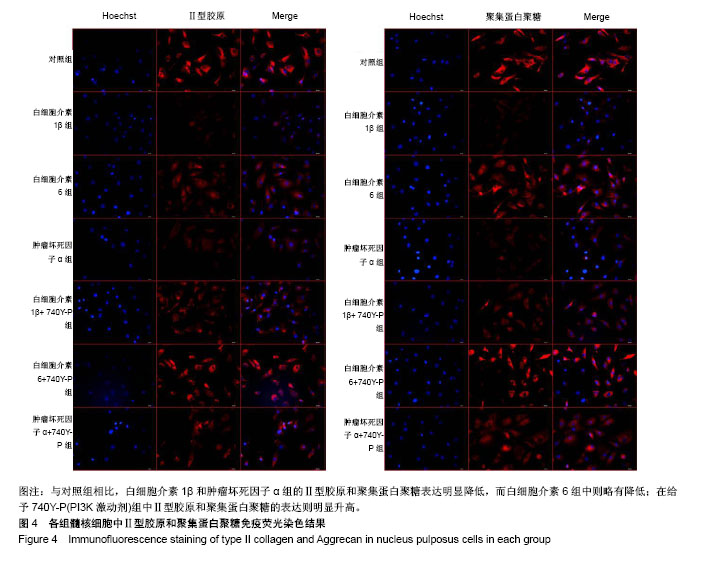| [1] McCarron RF,Wimpee MW,Hudkins PG et al. The inflammatory effect of nucleus pulposus. A possible element in the pathogenesis of low-back pain. Spine.1987;12(8):760-764.[2] Kalichman L,Hunter DJ. The genetics of intervertebral disc degeneration: Familial predisposition and heritability estimation.Joint Bone Spine.2008;75:383-387.[3] Masuda K. Biological repair of the degenerated intervertebral disc by the injection of growth factors. Eur Spine J. 2008; 17(Suppl 4): 441-451. [4] Shamji MF, Setton LA, Jarvis W, et al. Proinflammatory cytokine expression profile in degenerated and herniated human intervertebral disc tissues. Arthritis Rheum. 2010;62(7): 1974-1982. [5] Studer RK,Vo N,Sowa G, et al. Human nucleus pulposus cells react to IL-6: independent actions and amplification of response to IL-1 and TNF-α. Spine. 2011; 36(8):593-599.[6] Scheller J, Garbers C, Rose-John S. Interleukin-6: From basic biology to selective blockade of pro-inflammatory activities. Semin Immunol. 2013;11:002.[7] Shen Jieliang,Xu Shengxi,Zhou Hao et al. IL-1β induces apoptosis and autophagy via mitochondria pathway in human degenerative nucleus pulposus cells. Sci Rep.2017; 7: 41067.[8] Studer RK,Gilbertson LG,Georgescu H, et al. p38 MAPK inhibition modulates rabbit nucleus pulposus cell response to IL-1. Orthop. Res. 2008; 26(7): 991-998.[9] Mwale F,Wang HT,Zukor DJ et al. Effect of a Type II Collagen Fragment on the Expression of Genes of the Extracellular Matrix in Cells of the Intervertebral Disc. Open Orthop J. 2008;2:1-9.[10] Gorth DJ, Mauck RL, Chiaro JA, et al. IL-1ra delivered from poly(lactic-co-glycolic acid) microspheres attenuates IL-1β-mediated degradation of nucleus pulposus in vitro. Arthritis Res Ther. 2012;14(4): R179.[11] Cuéllar JM, Borges PM, Cuéllar VG, et al. Cytokine expression in the epidural space: a model of noncompressive disc herniation-induced inflammation. Spine. 2013; 38(1): 17-23.[12] Studer RK, Aboka AM, et al. p38 MAPK inhibition in nucleus pulposus cells: a potential target for treating intervertebral disc degeneration. Spine. 2007; 32(25): 2827-2833.[13] Freemont AJ.The cellular pathobiology of the degenerate intervertebral disc and discogenic back pain. Rheumatology (Oxford). 2009;48(1):5-10. [14] Vergroesen PP,Kingma I,Emanuel KS,et al. Mechanics and biology in intervertebral disc degeneration:a vicious circle. Osteoarthri- tis Cartilage.2015;23(7):1057-1070. [15] Global Burden of Disease Study 2013 Collaborators. Global,region al,and national incidence,prevalence,and years lived with disability for 301 acute and chronic diseases and injuries in 188 countries,1990-2013:a systematic analysis for the Global Burden of Disease Study 2013. Lancet. 2015;386(9995):743-800. [16] Willems N, Tellegen AR, Bergknut N, et al. Inflammatory profiles in canine intervertebral disc degeneration. BMC Vet. Res.2016;12:10.[17] Gu SX, Li X, Hamilton JL, et al. MicroRNA-146a reduces IL-1 dependent inflammatory responses in the intervertebral disc. Gene. 2015; 555(2): 80-87.[18] Zhou T, Lin H, Cheng Z, et al. Mechanism of microRNA-146a- mediated IL-6/STAT3 signaling in lumbar intervertebral disc degeneration. Exp Ther Med, 2017, 14(2): 1131-1135.[19] Yang H, Gao F, Li X, et al. TGF-β1 antagonizes TNF-α induced up-regulation of matrix metalloproteinase 3 in nucleus pulposus cells: role of the ERK1/2 pathway. Connect. Tissue Res. 2015;56(6): 461-468. [20] Freemont AJ. Keep up the heat on IL-l. Blood. 2012; 120(13): 2538-2539.[21] Croker BA, Kiu H,Roberts AW.IL-6 promotes acute and chronic inflammatory disease in the absence of SOCS3.Immunol Cell Biol. 2012;90 (1):124-129.[22] Hiyama A, Yokoyama K, Nukaga T,et al. A complex interaction between Wnt signaling and TNF-α in nucleus pulposus cells. Arthritis Res Ther. 2013;15(6): R189.[23] Holm S,Mackiewicz Z,Holm AK et al. Pro-inflammatory, pleiotropic, and anti-inflammatory TNF-alpha, IL-6, and IL-10 in experimental porcine intervertebral disk degeneration.Vet. Pathol. 2009; 46(6): 1292-300.[24] Kim HJ, Yeom JS, Koh YG, et al.Anti-inflammatory effect of platelet-rich plasma on nucleus pulposus cells with response of TNF-α and IL-1. Orthop. Res.2014; 32(4): 551-556.[25] Catabolic cytokine expression in degenerate and herniated human intervertebral discs: IL-1beta and TNFalpha expression profile.Arthritis Res Ther. 2007; 9(4): R77.[26] Le Maitre CL, Hoyland JA, Freemont AJ. Catabolic cytokine expression in degenerate and herniated human intervertebral discs: IL-1beta and TNF alpha expression profile. Arthritis Res Ther. 2007;9(4):R77. [27] Jiang L,Zhang X,Zheng X,et al. Apoptosis,senescence,and autophagy in rat nucleus pulposus cells:implications for diabetic intervertebral disc degeneration. J Orthop Res. 2013; 31(5): 692-702. [28] Chen ZH,Jin SH,Wang MY,et al. Enhanced NLRP3,caspase 1, and IL 1β levels in degenerate human intervertebral disc and their association with the grades of discdegeneration. Anat Rec(Hoboken).2015;298(4):720-726.[29] Yang W,Yu XH,Wang C, et al. Interleukin-1β in intervertebral disk degeneration.Clin Chim Acta. 2015; 450: 262-272.[30] Phillips KL,Jordan Mahy N,Nicklin MJ,et al. Interleukin 1 receptor antagonist deficient mice provide insights into pathogenesis of human intervertebral disc degeneration. Ann Rheum Dis.2013;72(11):1860-1907. [31] Gruber HE,Hoelscher GL,Ingram JA,et al. Increased IL 17 expression in degenerated human discs and increased production in cultured annulus cells exposed to IL 1β and TNF α. Biotech Histochem.2013;88(6):302-310. [32] Cai F,Zhu L,Wang F, et al. The Paracrine Effect of Degenerated Disc Cells on Healthy Human Nucleus Pulposus Cells Is Mediated by MAPK and NF-κB Pathways and Can Be Reduced by TGF-β1.DNA Cell Biol. 2017; 36: 143-158.[33] Wang C,Yu XH,Yan Y, et al. Tumor necrosis factor-α: a key contributor to intervertebral disc degeneration.Acta Biochim. Biophys Sin. 2017;49:1-13.[34] Cornejo MC,Cho SK,Giannarelli C,et al. Soluble factors from the notochordal rich intervertebral disc inhibit endothelial cell inva- sion and vessel formation in the presenceand absence of pro inflammatory cytokines. Osteoarthritis Cartilage.2015;23 (3):487 - 496. [35] Yang H, Liu H, Li X, et al. TNF-α and TGF-β1 regulate Syndecan-4 expression in nucleus pulposus cells: role of the mitogen-activated protein kinase and NF-κB pathways.Connect Tissue Res.2015; 56: 281-287.[36] Wang WJ, Yu XH, Wang C, et al.MMPs and ADAMTSs in intervertebral disc degeneration.Clin Chim Acta. 2015; 448: 238-246.[37] Walter BA,Likhitpanichkul M,Illien Junger S,et al.TNF-α transport induced by dynamic loading alters biomechanics of intact intervertebral discs. PLoS One.2015;10(3):e0118358. |
.jpg)


.jpg)
.jpg)
.jpg)